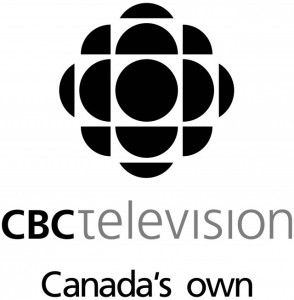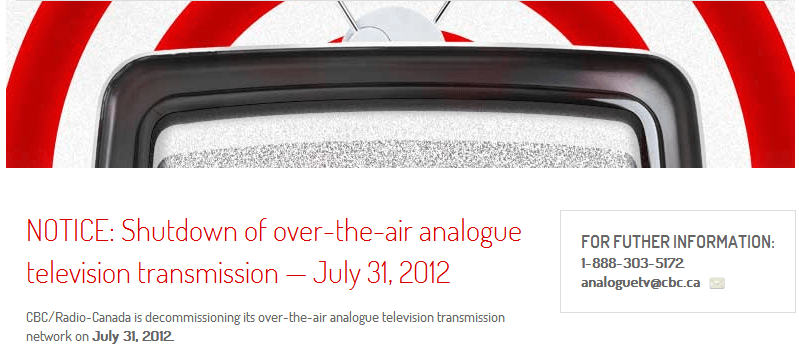 The Canadian Broadcasting Corporation today shut down more than 600 analog television transmitters primarily serving rural viewers, forcing most to either go without television to sign up for commercial satellite or cable television service.
The Canadian Broadcasting Corporation today shut down more than 600 analog television transmitters primarily serving rural viewers, forcing most to either go without television to sign up for commercial satellite or cable television service.
Because of Canada’s great expanse, the country’s public broadcaster has relied on hundreds of terrestrial low-power television transmitters to cover smaller communities and rural areas outside of the reach of CBC stations in larger cities. These transmitters provide relays of 27 regional English and French stations and have allowed rural residents to enjoy free over-the-air television.
While larger communities are now able to watch digital television signals in place of older analog service, the CBC has decided not to replace existing analog repeater transmitters with digital ones, effectively ending service for many rural Canadians who will now receive no over the air signals at all. Budget challenges and a decision from the CRTC that declared the CBC has no obligation to broadcast its programming has been met with resistance across rural Canada, particularly because taxpayers in cities large and small finance the CBC’s operations.
As of today, the CBC will rely entirely on the 27 digital television stations it will continue to operate over the public airwaves nationwide. Critics say that is contrary to the CBC’s mandate in the Broadcasting Act, which declares the CBC is Canada’s “national public broadcaster.”
“The TV transmitter infrastructure is worth millions and was paid for by Canadian taxpayers,” says Catherine Edwards of the Canadian Association of Community Television Users and Stations. “More than 2000 Canadians protested the shutdown in letters to the CRTC last month. They asked that the infrastructure be offered to communities to maintain for themselves. The federal government seems to be doing everything it can to cripple the national broadcaster and turn it into a pay specialty service, available to well-heeled Canadians in big cities.”
“The CBC-TV and Radio-Canada analog transmitter shutdown is a sad chapter in Canada’s digital transition,” says Karen Wirsig of the Canadian Media Guild. “We understand that CBC is in a financial bind with $155 million in cuts required by 2015. Something had to give. Evidently infrastructure outside of major cities is not a priority for the federal government, despite rhetoric about the digital economy.”
The CBC says the change will impact only 2 percent of Canadians that do not already receive digital television service or have signed up with a pay television provider. But the concept of “free TV” has changed forever for rural viewers.
For some cable viewers, the CBC’s digital solution is also presenting problems, especially in the Maritimes. In rural Newfoundland and Labrador, EastLink viewers may lose their closest local CBC station and be forced to watch programming from a CBC station is Halifax, Nova Scotia instead, at least until Shaw begins carrying additional CBC stations on satellite.
The Canadian Broadcasting Corporation today shut down more than 600 relay transmitters providing rural Canada with over-the-air access to the public broadcaster with a mandate to serve all of Canada. Now, viewers in rural Newfoundland and Labrador are going to be stuck watching “local” news and weather intended for Halifax, Nova Scotia. CBC Radio in Newfoundland and Labrador talks with the CBC about the reason for the disruption. (July 30, 2012) (8 minutes)
You must remain on this page to hear the clip, or you can download the clip and listen later.
Shaw’s “Local Television Satellite Solution”
In 2010, Shaw Communications, which owns Shaw Cable and Shaw Direct — a major satellite TV provider, announced its intention to buy Global TV — a major Canadian television network. For Americans, this would be the equivalent of Comcast owning your local cable company, NBC, and DirecTV. The Canadian Radio-television and Telecommunications Commission (CRTC), Canada’s telecommunications regulator, agreed to a deal offered by Shaw to acquire Global in return for offering Canadians who have not had satellite or cable service in the last 90 days a temporary free satellite solution for receiving “local stations.”

This customer ran out of luck when he needed Shaw to install just over 250 feet of cable from the nearest clear spot for the satellite to his home. Shaw limits installers to 250 feet, no more. The installer packed up and left shortly after learning an exception would have to be made. (Photo: PGM/Dude, ‘Where’s My TV?’ blog)
Shaw’s Local Television Satellite Solution (LTSS) offers qualified Canadians free satellite service with a handful of over-the-air stations, assuming they apply by November 2012.
Assuming your postal code is within a “qualified reception zone,” and you somehow know about the barely promoted service, Shaw will provide a satellite dish, receiver, and reasonable installation at no charge.
Unfortunately, many Canadians have no idea Shaw is offering the service, and are opting to purchase a regular Shaw Direct package, signing up with another satellite provider, or subscribing to cable where available. Very little about the service is found on Shaw Direct’s website, and those interested are required to call the company for further information. Even those made aware of Shaw’s offer have found challenges signing up.
Steven James May, who runs the “Dude, Where is My TV?” blog reports his parents, who live in rural Denbigh, Ontario were first made aware of Shaw’s LTSS when he told them about it. Several initial attempts to sign up for the service were dashed when Shaw responded Denbigh residents were not qualified for LTSS based on the postal code provided. When May’s parents eventually did qualify, they were sent a well-used and scuffed Star Choice satellite receiver retired from the days Shaw Direct was known as Star Choice.
After installation, the Ontario residents ended up with a dozen primarily over-the-air channels from across Canada:
- 2 Shaw Direct’s home channel
- 9 Knowledge Network
- 23 CTV 2 Alberta
- 37 CBC Toronto
- 39 Global Toronto
- 40 CityTV Toronto
- 41 CHCH Hamilton
- 42 OMNI
- 44 CTV Toronto
- 50 MCTV Sudbury (CTV)
- 52 Global Thunder Bay
- 55 TVOntario (Educational)
While enticing, Denbigh residents have effectively lost “local service” because the community is forced to watch local news for Toronto, Hamilton, Sudbury, Thunder Bay, and Calgary — all much further away than the nearest large city for them — Ottawa. Residents that used to watch CJOH (CTV Ottawa) and CBOT (CBC Ottawa) over-the-air now must get accustomed to news and weather for Toronto, a considerable distance to the west.
“This is a major public policy failure,” adds Edwards. “Everyone has known that the digital transition was coming for two decades. It’s supposed to increase our communications services, yet no one would step up to the plate and take leadership to make sure that neither rural Canada nor our national public broadcaster would be crippled: not Heritage, not the CRTC, not the CBC, and certainly not the federal government.”


 Subscribe
Subscribe

